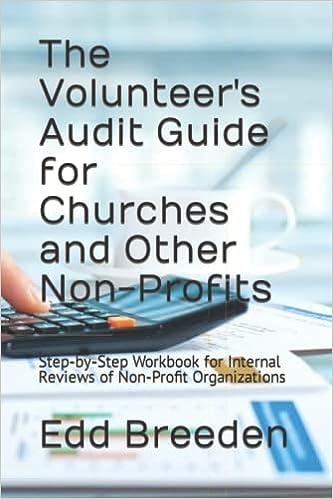Answered step by step
Verified Expert Solution
Question
1 Approved Answer
target walmart appendix D more information on target more information on walmart Refet to the financial statements of Target (Agpendix B) and Waimart (Apgendix C)

target
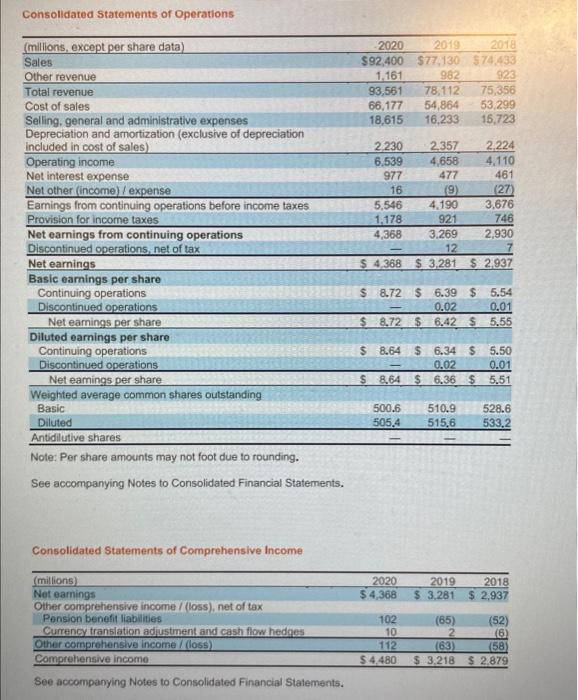
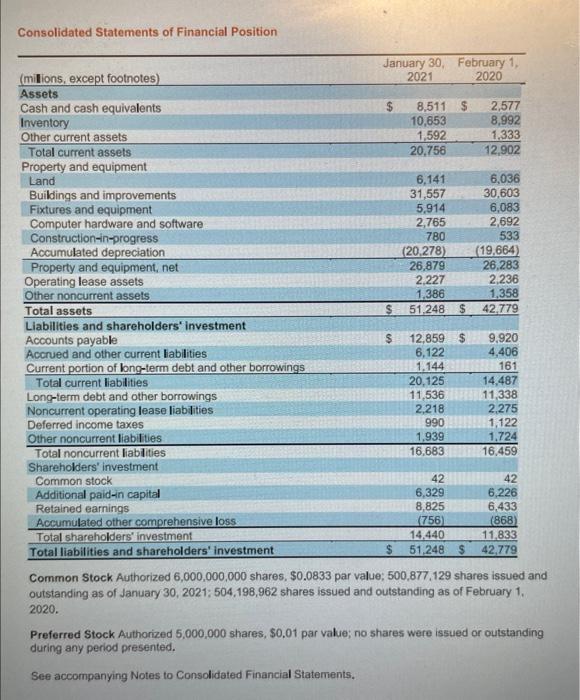
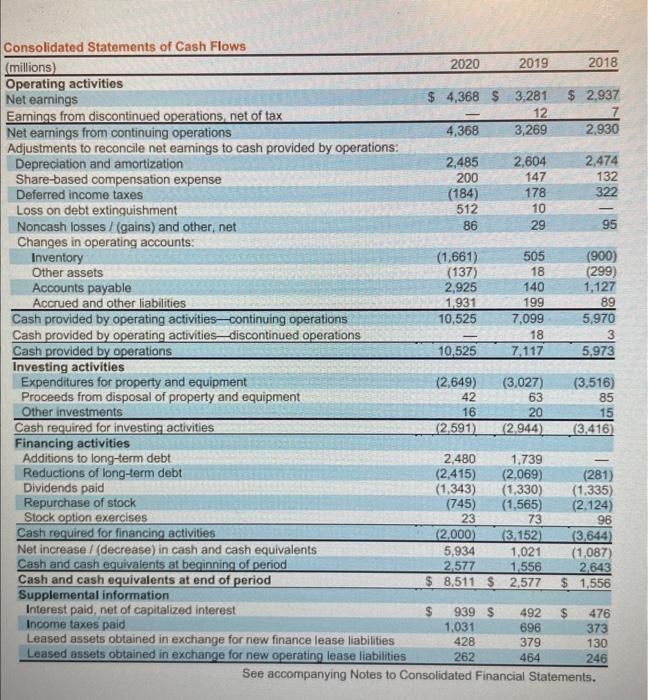
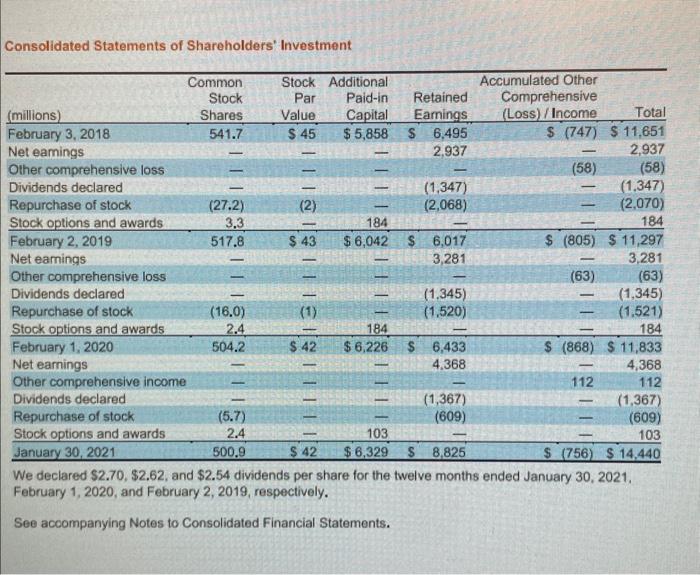
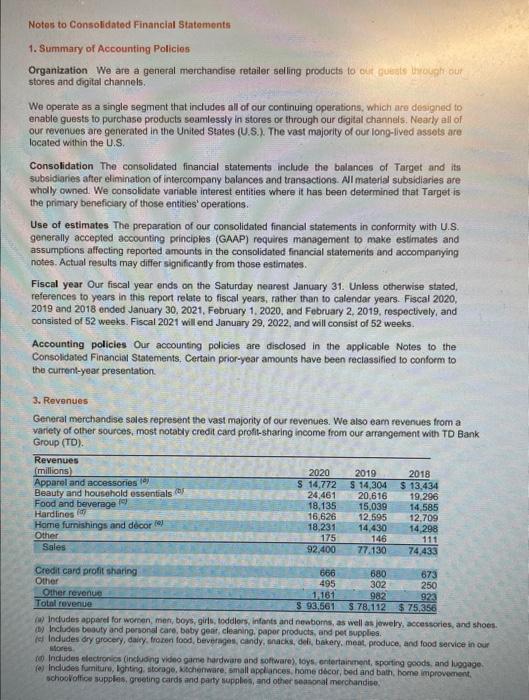

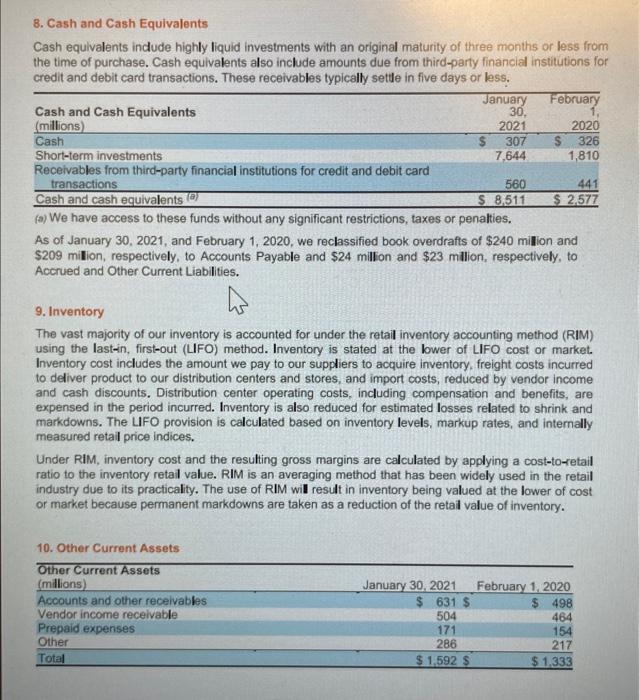
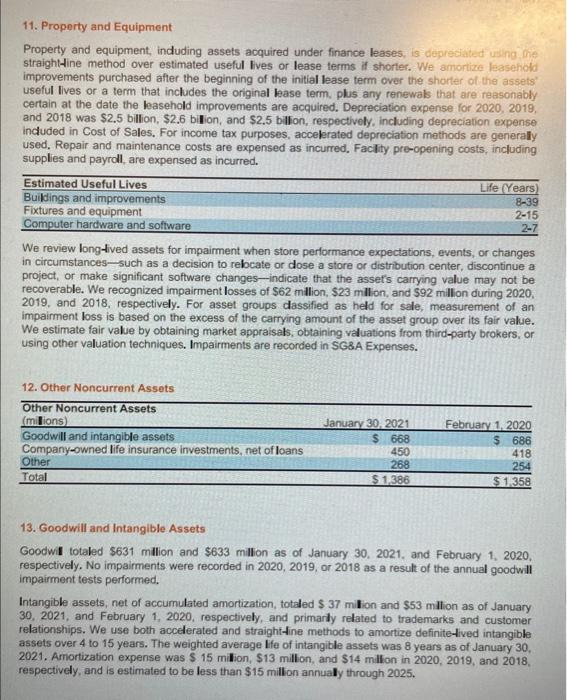
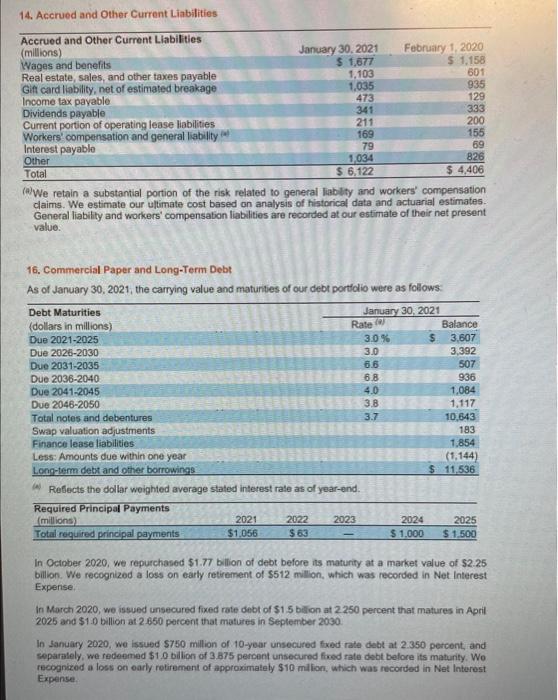
walmart
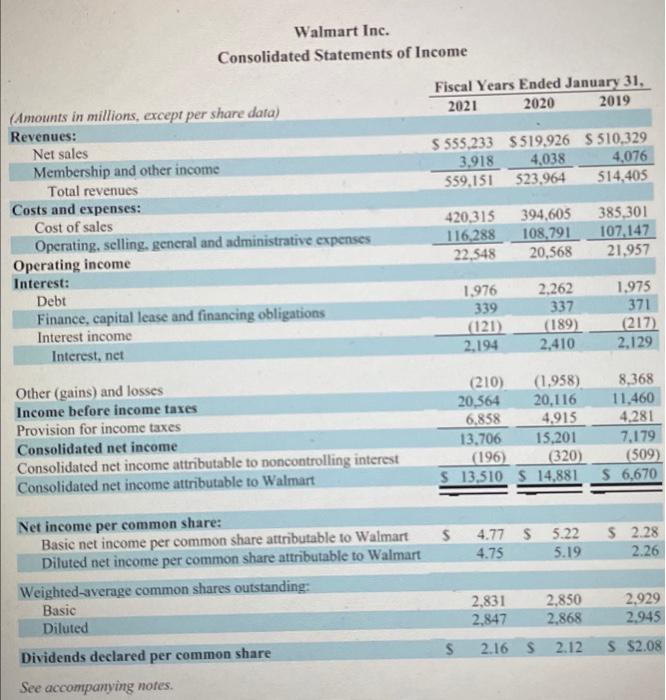
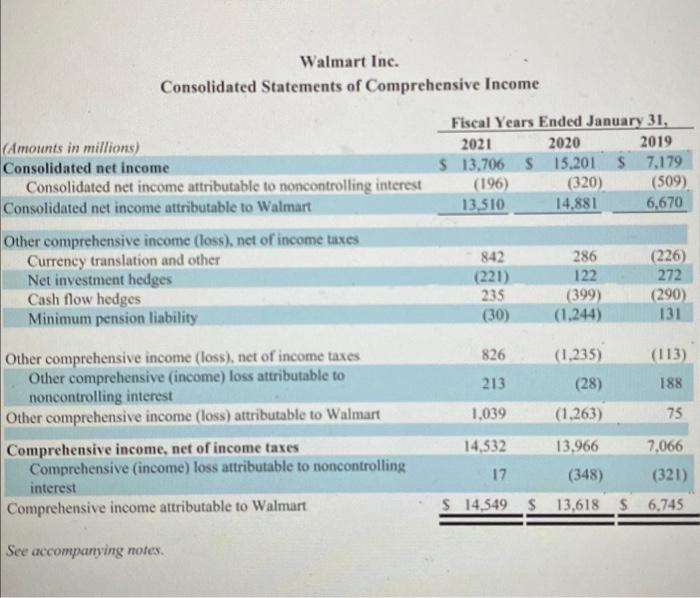
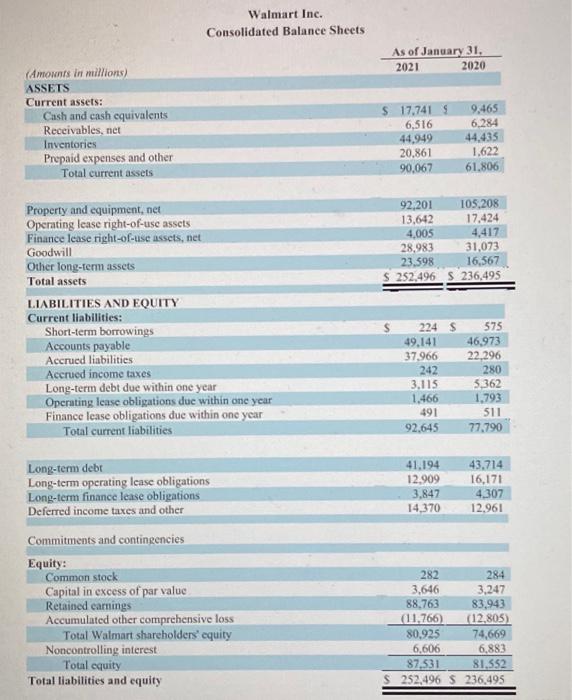
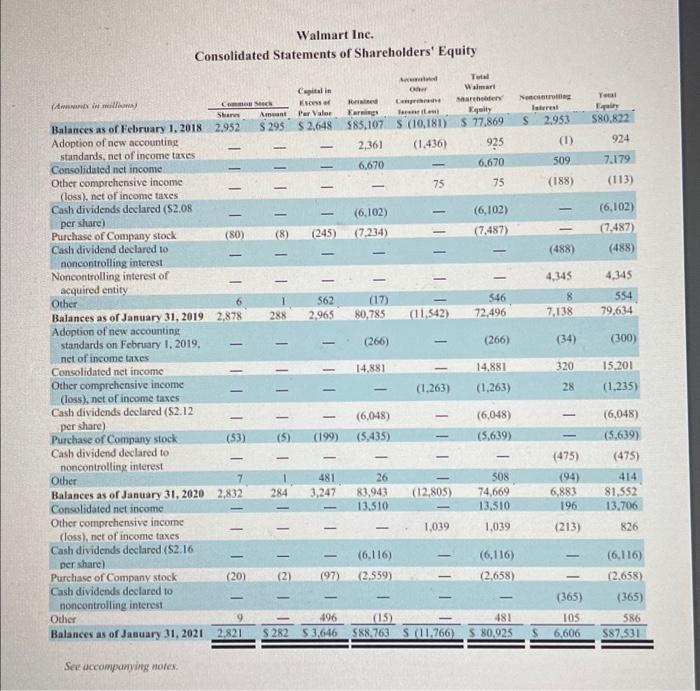
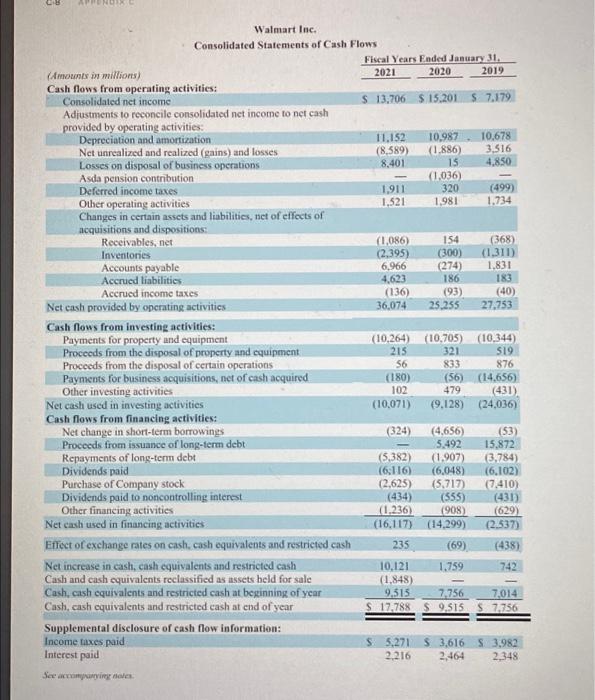
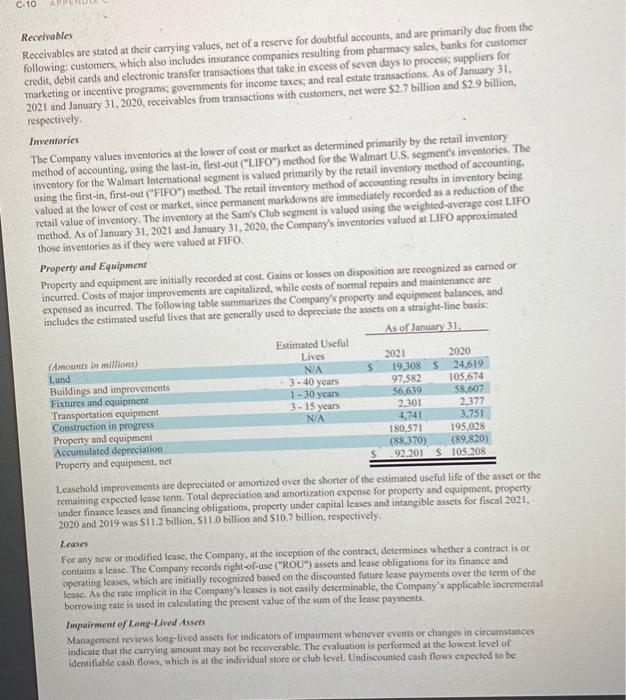
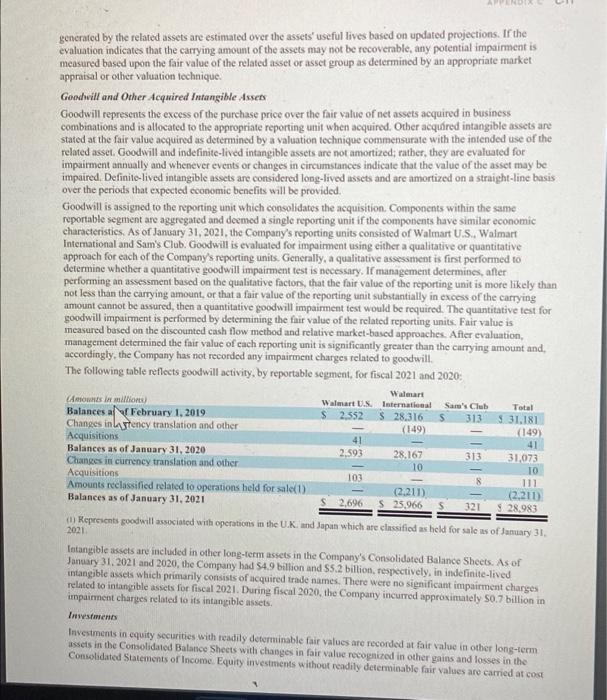
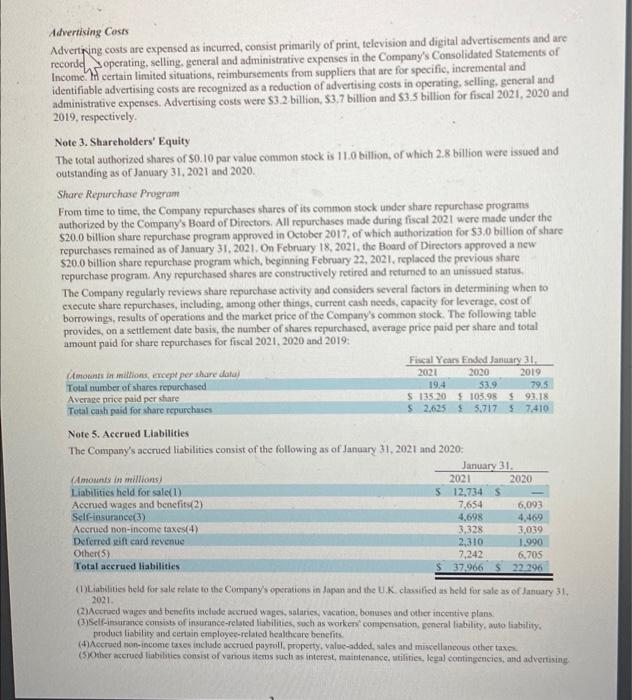
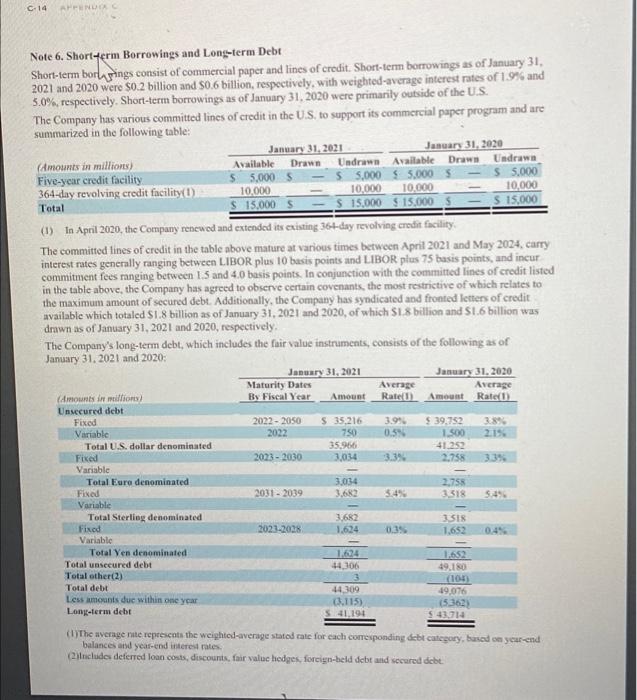
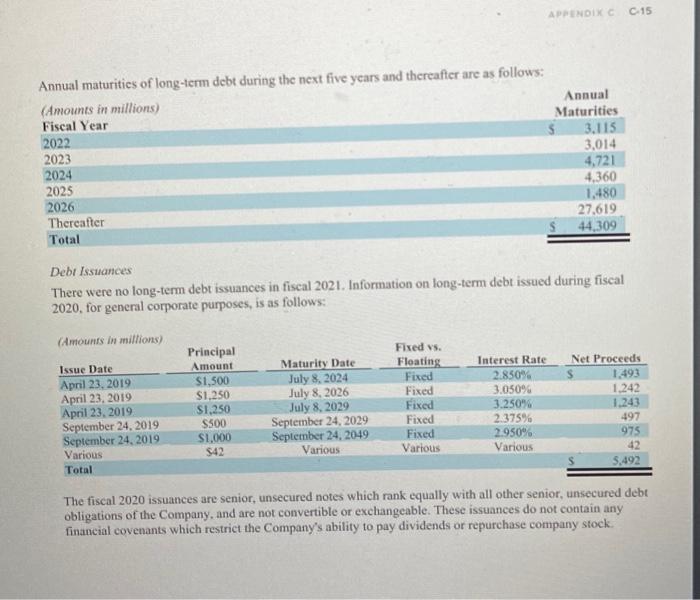
appendix D
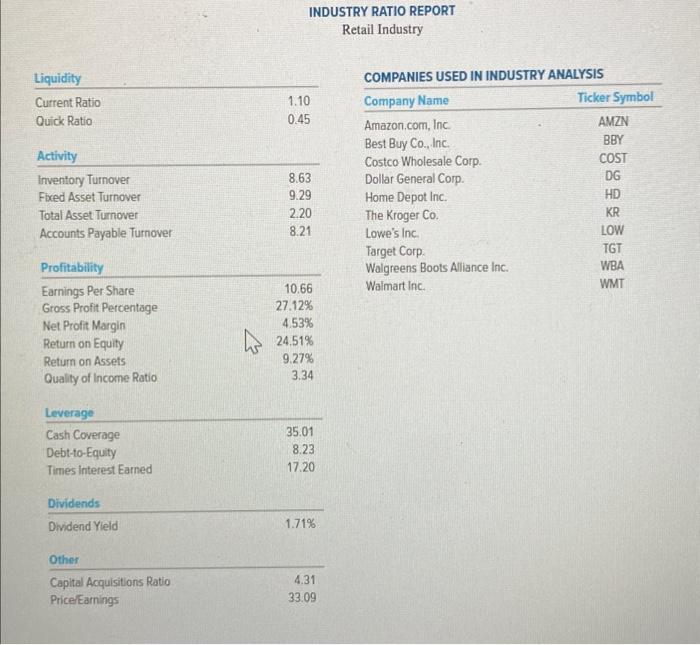
more information on target 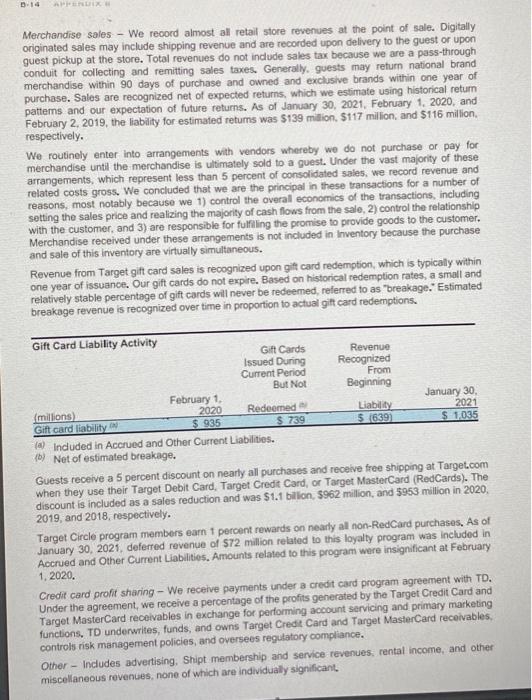
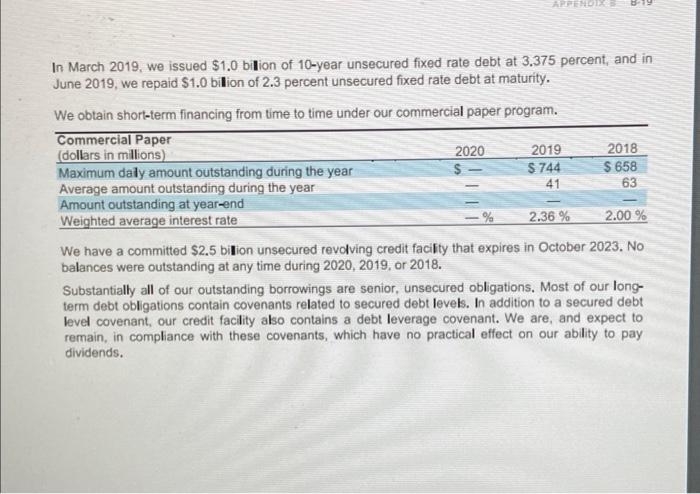
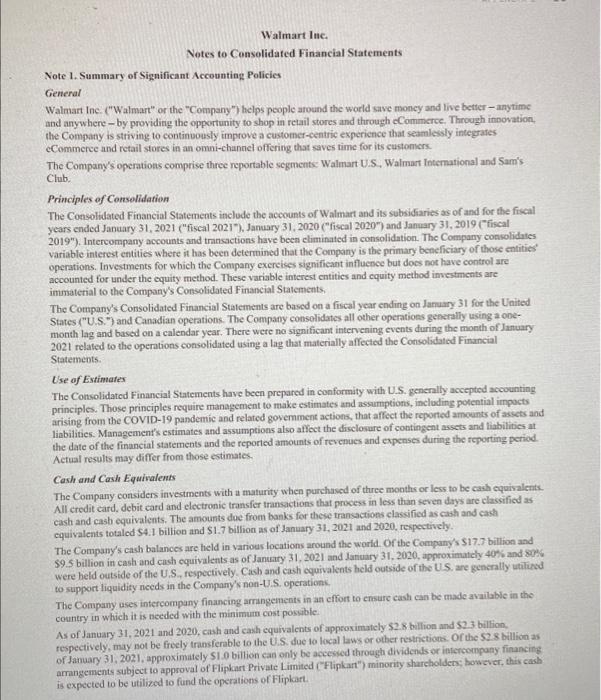
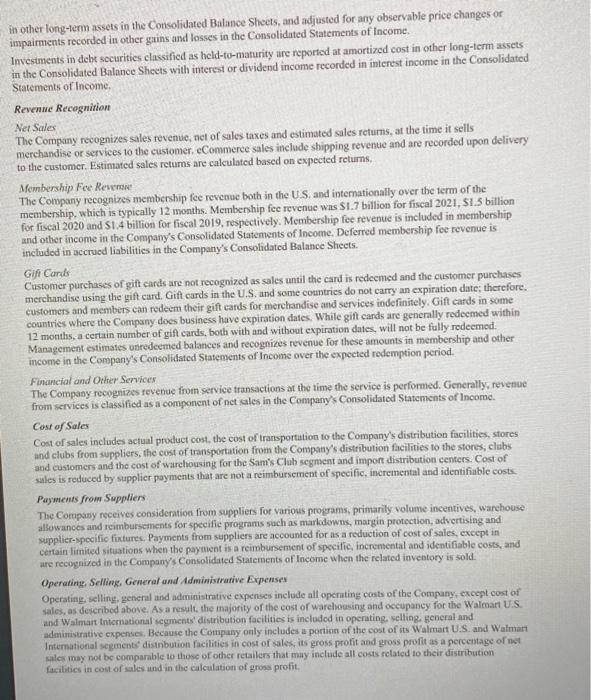
Refet to the financial statements of Target (Agpendix B) and Waimart (Apgendix C) and the Industry Ratio Report (Agoendix D) Required: 1. Compute the total asset turnover ratio for both companies for the most recent fiscal year Round your answer to nwo decimal places 2. Compare the total asset tumover ratios for Target and Walmart to the average total asset turnover ratio for the retail industry Are Target and Waimart more or less effective at using their assets to generate revenue compared to the industry average? 3. Compute the cash coverage ratio for both companies for the most recent fiscal year Round your answer to twro decimal places. 4. Which company generated a greater amount of cash from operating activities relative to interest paid during the most recent fiscal year? 5. Compute the pricelearnings ratio for both companies for the most recent fiscal yeat. Round your andwer to two decimal places (Note. Target and Waimartis stock price at the end of the most recent fiscal year was 518117 and $13927, respectively) 6. According to their priceiesrnings ratio, which company does the market expect will increase their earnings more rapidy in the future? Consolidated Statements of Operations Note: Per share amounts may not foot due to rounding. See accompanying Notes to Consolidated Financial Statements. Consolidated Statements of Comprehensive Income See accompanying Notes to Consolidated Financial Statements. Consolidated Statements of Financial Position outstanding as of January 30,2021;504,198,962 shares issued and outstanding as of February 1 . 2020. Preferred Stock Authorized 5,000,000 shares, $0,01 par value; no shares were issued or outstanding during any period presented. See accompanying Notes to Consolidated Financial Statements. Consolidated Statements of Cash Flows See accompanying Notes to Consolidated Financial Statements. Consolidated Statements of Shareholders' Investment February 1, 2020, and February 2, 2019, respectively. See accompanying Notes to Consolidated Financial Statements. Notes to Consolidated Financial Statements 1. Summary of Accounting Policies Organization We are a general merchandise retailer selling products to ocif gutsis larcughtiour? stores and digital channels. We operate as a single segment that includes all of our continuing operations, which are deaigned to enable guests to purchase products seamlessly in stores or through our digital channels. Nearly all of our revenues are generated in the United States (U.S.). The vast majority of our long-lived assels are located within the U.S. Consolidation The consolidated financial statements include the balances of Target and its subsidiaries after elimination of intercompany balances and transactions. Al material subsidiaries are whally cwned. We consolidate variable interest entities where it has been determined that Target is the primary beneficiary of those entities' operations. Use of estimates The preparation of our consolidated financial statements in conformity with U.S. generally accepted accounting principlos (GAAP) requires management to make estimates and assumptions affocting reported amounts in the consolidated financial statements and accomparying notes. Actual results may differ significantly from those estimates. Fiscal year Our fiscal year ends on the Saturday nearest January 31. Unless otherwise stated, references to years in this report relate to fiscal years, rather than to calendar years. Fiscal 2020, 2019 and 2018 ended January 30, 2021. February 1, 2020, and February 2, 2019, respectively, and consisted of 52 weeks. Fiscal 2021 will end January 29,2022 , and will consist of 52 weeks. Accounting policies Our accounting policies are disclosed in the applicable Notes to the Consoldated Financial Statements, Certain prior-year amounts have been reclassified to conform to the curnent-year presentation. 3. Revenues General merchandise sales represent the vast majority of our revenues. We also earn revenues from a variety of other sources, most notably credit card prolit-sharing income from our arrangement with TD Bank Group (TD). (0) Indudes apparel for wornen, moh, boys, girls, toddlork, infants and newborns, as well as pwwely, accestories, and shoes. (b) loctudes beouty and personal care, boty gear, cleaning. papor products, and pet wupplies. fer Indudes dry grocery, daicy, frosen food, beveragnes, candy, mnachs, deli, bakery, meat, produce, and food service in our ro. Indudes electronios (insluoing video game hardwiare and sottware), loys, ontertaingent, sporting goods, and luggage. (e) Indudes fumiture, Igriting, storogo, Kibchenware, small apel ances, home dbcor, bed and bath, homeots, and luggage schoovolfice supgles, greeting cards and party supplies, and other peasoral merchandise. 4. Cost of Sales and Selling, General and Administrative Expenses The following table illustrates the primary items classified in each major expense category: Note: The classification of the expenses varies across the retail industry. 7. Fair Value Measurements Fair value measurements are reported in one of three levels based on the lowest level of significant input used: Level 1 (unadjusted quoted prices in active markets); Level 2 (observable market inputs, other than quoted prices included in Level 1): and Level 3 (unobservable inputs that cannot be corroborated by observable market data). (v) Carrying value approximates fair value because maturities are less than three months. (o) Initially valued at transaction price, Subsequently valued by reference to the market price of Target common stock (c) Represents our investment in Casper common stock. (a) Valuations are based on observable inputs to the valuation model (e.g. interest rates and credit spreads). In 2020 and 2019, we recorded pretax losses of $19 million and $41 million, respectively, related to our invesiment in Casper within Net Other (Income) / Expense. We sold our investment during 2020. 8. Cash and Cash Equivalents Cash equlvalents indude highly liquid investments with an original maturity of three months or less from the time of purchase. Cash equivalents also include amounts due from third-party financial institutions for credit and debit card transactions. These receivables typically sette in five days or less. (a) We have access to these funds without any significant restrictions, taxes or penalties. As of January 30, 2021, and February 1, 2020, we reclassified book overdrafts of $240 million and $209 milion, respectively, to Accounts Payable and \$24 million and $23 million, respectively, to Accrued and Other Current Liabilities. 9. Inventory The vast majority of our inventory is accounted for under the retail inventory accounting method (RIM) using the last-in, first-out (UFO) method. Inventory is stated at the bwer of LIFO cost or market. Inventory cost includes the amount we pay to our suppliers to acquire inventory, freight costs incurred to deliver product to our distribution centers and stores, and import costs, reduced by vendor income and cash discounts. Distribution center operating costs, including compensation and benefits, are expensed in the period incurred. Inventory is also reduced for estimated losses related to shrink and markdowns. The LIFO provision is calculated based on inventory levels, markup rates, and internally measured retail price indices. Under RIM, inventory cost and the resulting gross margins are calculated by applying a cost-to-retail ratio to the inventory retail value. RIM is an averaging method that has been widely used in the retail industry due to its practicality. The use of RIM will result in inventory being valued at the lower of cost or market because permanent markdowns are taken as a reduction of the retail value of inventory. 11. Property and Equipment Property and equipment, induding assets acquired under finance leases, is doprectated uing ine. straight-line method over estimated useful lives or lease terms if shorter. We amortize leasehold improvements purchased after the beginning of the initial lease term over the shorter of the assets useful lives or a lerm that includes the original laase term, plus any renewals that are reasonably certain at the date the leasehold improvements are acquired. Depreciation expense for 2020, 2019, and 2018 was $2.5 billion, $2.6 bilion, and $2.5 billon, respectively, including depreciation expense induded in Cost of Sales, For income tax purposes, accekrated depreciation methods are generally used. Repair and maintenance costs are expensed as incurred. Facily pre-opening costs, including supplies and payroll, are expensed as incurred. We review long-ived assets for impairment when store performance expectations, events, or changes in circumstances - such as a decision to rebcate or dose a store or distribution center, discontinue a project, or make significant software changes-indicate that the asset's carrying value may not be recoverable. We recognized impairment losses of $62milion,$23 millon, and $92 million during 2020 , 2019, and 2018, respectively. For asset groups dassified as held for sale, measurement of an impairment loss is based on the excess of the carrying amount of the asset group over its fair value. We estimate fair value by obtaining market appraisals, obtaining valuations from third-party brokers, or using other valuation techniques. Impairments are recorded in SGBA Expenses. 13. Goodwill and Intangible Assets Goodwi totaled $631 million and $633 millon as of January 30, 2021. and February 1, 2020, respectively. No impairments were recorded in 2020,2019 , or 2018 as a result of the annual goodwill impairment tests performed. Intangible assets, net of accumulated amortization, totaled $37mil ion and $53mill in as of January 30. 2021, and February 1, 2020, respectively, and primarily related to trademarks and customer relationships. We use both accelerated and straight-line methods to amortize definite-lived intangible assets over 4 to 15 years. The weighted average life of intangible assets was 8 years as of January 30 , 2021. Amortization expense was \$ 15 milion, $13 millon, and $14 millon in 2020, 2019, and 2018, respectively, and is estimated to be less than $15 millon annualy through 2025 . 14. Accrued and Other Current Liabilities (9) We retain a substantial portion of the risk related to general liablity and workers' compensation claims. We estimate our ullimate cost based on analysis of historical data and actuarial estimates. General liability and workers' compensabion liabilities are recorded at our estimate of their net present value. 16. Commercial Paper and Long-Term Debt As of January 30, 2021, the carrying value and maturties of our debt porttolio were as follows: In October 2020, we repurchased $1.77 billion of debt before is maturity at a market value of $2.25 bilion. We recoonizod a loss on early retirement of $512 millon, which was recorded in Net Interest Expense. In March 2020, we issued unsecured fixed rate debt of $1.5 billon at 2.250 percent that matures in April 2025 and $1.0 billion at 2.650 percent that matures in September 2030 In Sanuary 2020, we issued $750 million of 10 -year unsecured fxed rate debt at 2.350 percent, and separalely, we redeemed $1.0 bilion of 3.875 percent unsecured frod rate debt belore its maturity. Wo recopnized a loss on early retirement of approximately $10 milion, which was recorded in Net Interest Expense. Walmart Inc. Consolidated Statements of Income Walmart Inc. Consolidated Statements of Comprehensive Income Walmart Inc. Consolidated Balance Sheets Walmart Inc. Consolidated Statements of Shareholders' Equity Walmart lnc. Consolidated Statements of Cash Flows Recelvables are stated at their carrying values, net of a reserve for doubtful accounts, and are primarily due from the Receivables following customers, which also includes insurance companies resulting from pharmacy sales, banks for customer credit, debit cards and electronic transfer transactions that take in excess of seven days to process; suppliers for marketing or ineentive programs; govemments for income taxes; and real estate transactions. As of January 31 . 2021 and January 31,2020 , receivables from transactions with customers, net were $2.7 billion and $2.9 billion, respectively. The Company values inventories at the lower of cost or market as determined primarily by the retail inventory Inventories method of accounting, using the last-ith, first-out ("LIFO") method for the Walmart U.S. segments inventorics. The inveatory for the Walmart International segment is valued primarily by the retail inventory method of accounting. using the first-in, first-out ("FIFO") method. The retail inventory method of accounting results in imventory being valued at the lower of cost or market, since permanent markdowns are immediately recorded as a reduction of the retail value of inventory. The inventory at the Sam's Club segment is valued using the weighted-average cost LIFO method. As of January 31,2021 and January 31, 2020, the Company's inventories valued at LIFO approximated those inventories as if they were valued at FIFO. Property and equipment are initially recorded at cost. Gains or losses on disposition are recognized as carned or Property and Equipment incurred. Costs of major improvements are capitalized, while costs of normal repoirs and maintenance are expensed as incurred. The following table summarizes the Company's property and equipment balances, and includes the estimated useful tives that are generally used to depreciate the assets on a straight-line basis: Leasehold improvements are depreciated or amortizod over the shorter of the estimated userun ure on un usset or the remaining expected lease tem. Total depreciation and amortization expense for property and equipment, property. under finance leases and financing obligations, property under capital leases and intangible assets for fiseal 2021 , 2020 and 2019 was $11.2 billion, $11.0 billion and $10.7 billion, respectively. Lease For any new or modified lease, the Company, at the inception of the contract, determines whether a contract is or contains a lease. The Company records right-of-use ("ROUT) assets and lease obligations for its finance and operating leases, which are initially recognioed based on the discounted future lease payments over the term of the lease. As the rate implicit in the Company's leases is not easily determinable, the Company's applicable increnental bonrwing rate is used in calculating the present value of the sum of the lease payments timpairment of Leng-Lived Assets Managenent reviews long-lived assets for indicatos or impoirment whenever events or changes in circumstances indicate that the earrying anount may not be recoveruble. The evaluation is performed at the lowest level of identifiable cash flows, which is at the individual store or club level. Undincounted cash flows expected to be generated by the related assets are estimated over the assets' useful lives based on updated projections. If the evaluation indicates that the carrying amount of the assets may not be rocoverable, any potential impaimment is measured bascd upon the fair value of the related asset or asset group as determined by an appropriate market appraisal or other valuation technique. Goodwill and Other Acquired Intangible Assets Goodwill represents the excess of the purchase price over the fair value of net assets acquired in business combinations and is allocated to the appropriate reporting unit when acquired. Other acquired intangible assets are stated ar the fair value acquired as determined by a valuation technique commensurate with the intended use of the related assel. Goodwill and indefinite-lived intangible assets are not amortized; rather, they are evaluated for impairment annually and whenever events or changes in circumstances indicate that the value of the asset may be impaired. Definile-lived intangible assets are considered long-lived assets and are amortized on a straight-line basis over the periods that expected cconomic benefits will be provided Goodwill is assigned to the reporting unit which consolidates the acquisition. Components within the same reportable segment are aggregated and deemed a single reporting unit if the components have similar economic characteristics. As of January 31, 2021, the Compaely's reporting units consisted of Walmart U.S. Walmart International and Sam's Club. Goodwill is evaluated for impairment using cither a qualitative or quantitative approach for each of the Company's reporting units. Generally, a qualitative assessment is first performed to determine whether a quantitative goodwill impaiment test is necessary. If management determines, after performing an assessment based on the qualitative facton, that the fair value of the reporting unit is more likely than not less than the carrying amount, or that a fair value of the reporting unit subitantially in excess of the carrying amount cannot be assured, then a quantitative goodwill impaimment test would be required. The quantitative test for goodwill impairment is performed by determining the fair value of the related reporting units, Fair value is measured based on the discounted cash flow method and relative market-based approaches. Affer evaluation, management determined the fair value of each reporting unit is significantly greater than the carrying amount and, accordingly, the Company has not recorded any impairment charges related to goodwill. The following table reflects goodwill activity, by reportable segment, for fiscal 2021 and 2020: (11 kepresents Eoodwill associated with operations in the U.K. and Japan which are clnssified as held for sale as of January 31 . Intangible assets are included in other long-term assets in the Company's Consolidated Balance Sheets. As of January 31,2021 and 2020, the Company had 54.9 billion and $5.2 billion, respectively, in indefinite-lived intangible assets which primarily consists of acquired trade names. There were no significant impairment charges related to intangible assets for fiscal 2021. During fiscal 2020, the Company incurred approximately S0.7 billion in impairment charges related to its intangible assets. Invesiments Investments in cquity sceurities with readily determinable fair values are recorded at fait value in other long-1erm assets in the Consolidaed Balasce Shects with changes in fair value rocopnized in other gains and losses in the Conselidated Statements of Income. Equity investments withoot readly dererminable fair values are carried at coce. Advertising Costs Adveriking costs are expensed as incurred, consist primarily of print, television and digital advertisements and are recorde yoperating, selling, general and administrative expenses in the Company's Consolidated Statements of Income. In certain limited situations, reimbursements from suppliers that are for specific, incremental and identifiable advertising costs are recognized as a reduction of advertising costs in operating, selling, general and administrative expenses. Advertising costs were $3.2 billion, $3.7 biltion and $3.5 billion for fiseal 2021,2020 and 2019, respectively. Note 3. Shareholders' Equity The total authorized shares of $0.10 par value common stock is 11.0 billion, of which 2.8 billion were issued and outstanding as of January 31,2021 and 2020 . Share Repurchase Program From time to time, the Company repurchases shares of its common stock under share repurchase programs authorized by the Company's Board of Dircctors. All repurchases made during fiscal 2021 were made under the \$20.0 billion share repurchase program approved in Oetober 2017 , of which authorization for 53.0 billion of share repurchases remained as of January 31, 2021. On Febnary 18, 2021, the Board of Directors approved a new \$20.0 billion share repurchase program which, beginning February 22, 2021, replaced the previous share repurchase program. Any repurchased shares are constructively retired and returned to an unissued status. The Company regularly reviews share reporchase activity and considers several factors in determining when to execute share repunchases, including, among other things, current cash needs, capacity for leverage, cost of borrowings, results of operations and the market price of the Company's common stock. The following table provides, on a settlement date basis, the number of shares repurchased, average price paid per share and total amount paid for share repurchases for fiscal 2021, 2020 and 2019 : Note 5. Acerued Liabilities The Company's accrued liabilities consist of the following as of January 31, 2021 and 2020: (1) Eiabilities behs for sale relate to the Company's operations in Japan and the U.K. clawified as held for sale as of Jasuary 31 . 2021 (2)Acerued wages and benefits inclode arerued wages, salaries, vacation, bonuses und olher incentive plans (3)Self-inarnace consist of insurance-related labilities, such as worken' conapensation, Eeneral liability, aulo liability, product liability and certain employes-relaled bealthcare benefits (4) Mecrued nan-ibcome taxer include acciued payroll, property, value-added, sales and miseellancous other tare. (5) Oher accued liabilitios consit of verhous items ruch as interst, maibtenance, wtilities, legal contingencies, and advertising. Note 6. Short-erm Borrowings and Lont-term Debt Short-term bor 5 ings consist of commercial paper and lines of credit. Short-term borrowings as of January 31 , 2021 and 2020 were $0.2 billion and $0.6 billion, respectively, with weighted-avenage interest rates of 1.916 and 5.0%, respectively. Short-term borrowings as of January 31,2020 were primarily outside of the U.S. The Company has various committed lines of credit in the U.S. to support its commercial paper program and are summarized in the following table: (1) In April 2020, the Company renewed and extended its existing 364-dsy revolving croat racury. The committed lines of crodit in the table above mature at vatious times between April 2021 and May 2024, carry interest rates generally ranging between L.IBOR plus 10 basis points and LIBOR plus 75 basis points, and incur commitment fees ranging between 1.5 and 4.0 basis points. In conjunction with the committed lines of credit listed in the table above, the Company has agreed to observe certain covenants, the most restrictive of which relates to the maximum amount of secured debt. Additionally, the Company has syndicated and fronted letters of credit available which totaled $1.8 billion as of January 31,2021 and 2020 , of which $1.8 bilion and $1.6 billion was drawn as of January 31,2021 and 2020 , respectively. The Company's long-term debt, which includes the fair value instruments, consists of the following as of January 31, 2021 and 2020: (1) The average nite repesenta the weiqhitod-averuge statod rate for each conciponding debt category, busod on year-end balances and yearend intered rates. (2)includer deferred loan conts, discounts, fair value hedges, forcign-beld debt and secared dete. Annual maturities of long-term debt during the next five years and thereafter are as follows: Debr Issuances There were no long-term debt issuances in fiscal 2021. Information on long-term debt issued during fiscal 2020, for general corporate purposes, is as follows: The fiscal 2020 issuances are senior, unsecured notes which rank equally with all other senior, unsecured debt obligations of the Company, and are not convertible or exchangeable. These issuances do not contain any financial covenants which restrict the Company's ability to pay dividends or repurchase company stock. INDUSTRY RATIO REPORT Retail Industry Merchandise sales - We record almost all retail store revenves at the point of sale. Digitally originated sales may include shipping revenue and are recorded upon delivery to the guest or upon guest pickup at the store. Total revenues do not indude sales tax because we are a pass-through conduit for collecting and remitting sales taxes. Generally. guests may return national brand merchandise within 90 days of purchase and owned and exclusive brands within one year of purchase. Sales are recognized net of expected returns, which we estimate using historical return pattems and our expectation of future returns. As of January 30, 2021. February 1, 2020, and February 2, 2019, the liability for estimated retums was $139 million, $117 milion, and $116 million. respectively. We routinely enter into arrangements with vendors whereby we do not purchase or pay for. merchandise until the merchandise is ultimately sold to a guest. Under the vast majority of these arrangements, which represent less than 5 percent of consolidated sales, we record revenue and related costs gross. We concluded that we are the principal in these transactions for a number of reasons, most notably because we 1) control the overall economics of the transactions, including selting the sales price and realizing the majority of cash flows from the sale, 2) control the relationship with the customer, and 3) are responsible for fulfiling the promise to provide goods to the customer. Merchandise received under these arrangements is not included in Inventory because the purchase and sale of this inventory are virtually simultaneous. Revenue from Target gift card sales is recognized upon giff card redemption, which is typically within one year of issuance. Our gift cards do not expire. Based on historical redemption rates, a small and relatively stable percentage of gift cards will never be redeemed, referred to as "breakage," Estimated breakage revenue is recognized over time in proportion to actual gitt card redemptions. (a) Included in Accrued and Other Current Labilyes. (b) Net of estimated breakage. Guests receive a 5 percent discount on nearly all purchases and receive free shipping at Targetcom when they use their Target Debit Card, Target Credit Card, or Target MasterCard (RedCards). The discount is included as a sales reduction and was $1.1 bilion, $962 mallion, and 5953 million in 2020. 2019, and 2018 , respectively. Target Circle program members earn 1 percent rewards on neanly all non-RedCard purchases. As of January 30, 2021, deferred revenue of 572 million related to this loyalty program was included in Accrued and Other Current Liabilitios. Amounts related to this program were insignificant at February 1,2020. Credit card profit sharing - We receive payments under a credit card program agreement with TD. Under the agreement, we receive a percentage of the profits generated by the Target Credit Card and Target MasterCard receivables in exchange for pertorming account servicing and primary marketing functions. TD underwrites, funds, and owns Target Credt Card and Target MasterCard receivables. controls risk management policies, and oversees regulatory compliance. Other - Includes advertising. Shipt membership and service rovenues; rental income, and other miscellaneous revenues, none of which are individually significant? In March 2019, we issued $1.0 bilion of 10 -year unsecured fixed rate debt at 3.375 percent, and in June 2019 , we repaid $1.0 bilion of 2.3 percent unsecured fixed rate debt at maturity. We obtain short-term financing from time to time under our commercial paper program. We have a committed $2.5 bilion unsecured revolving credit facilty that expires in October 2023. No balances were outstanding at any time during 2020, 2019, or 2018 . Substantially all of our outstanding borrowings are senior, unsecured obligations. Most of our longterm debt obligations contain covenants related to secured debt levels. In addition to a secured debt level covenant, our credit faciity also contains a debt leverage covenant. We are, and expect to remain, in complance with these covenants, which have no practical effect on our ability to pay dividends. Walmart Inc. Notes to Consolidated Financial Statements Note 1. Summary of Significant Accounting Policies General Walmart Ine. "Walmart" or the "Company") helps people around the world save moncy and live better - anytime and anywhere - by providing the opportunity to shop in relail stores and through cCommerce. Through innovation. the Company is striving to continuously improve a customer-centric expericnce that seamlesily integrates eCommeree and retail stores in an omni-channel offering that saves time for its customers. The Company's operations comprise three reportable segments: Walmart U/S, Walmart International and Sam's. Club. Principles of Comselidation The Consolidated Financial Statements include the accounts of Walmart and its subsidiaries as of and for the ficeal years ended January 31, 2021 ""fiscal 2021"). January 31, 2020 ("fiscal 2020") and January 31, 2019 ("fiscal 2019"). Intercompany accounts and tmnsactions have beea climinated in consolidation. The Company consolidates variable interest entities where it has been determined that the Company is the primary beneficiary of those entities operations. Investments for which the Company exercises significant influence but does not have control are accounted for under the equity method. These variable interest entities and equity method investments are immaterial to the Company's Consolidated Financial Statements. The Company's Consolidated Financial Statements are based on a fiscal year ending on January 31 for the Uhited States ("U.S.") and Canadian operations. The Company consolidates all other operntions generally using a onemonth lag and based on a calendar year. There were no significant intervening events during the month of January 2021 related to the operations consolidated using a lag that materially affected the Consolidated Financial Statements. Lse of Estimates The Consolidated Financial Statements have been prepared in conformaty with U.S. genenally accepted accounting principles. Those principles require management to make estimates and assumptions, incloding potential impocts arising from the COVID-19 pandemic and related govemment actions, that affect the reported amounts of assets and liabilities. Management's estimates and assumptions also affect the disclosure of contingent assets and liabilities at the date of the financial statements and the reported amounts of revenues and expenses during the reporting period. Actual results may differ from those estimates. Cash and Cash Equivalents The Company considers investments with a maturity when purchased of three months or less to be cash equisalents. All crodit card, debit card and electronic transfer transactions that process in less than seven days are classified as cash and casb equivalents. The amounts due from banks for these transctions classificd as cash and cash equivalents totaled $4.1 bilion and $1.7 bilfion as of January 31,2021 and 2020 , respectively. The Company's cash balances are held in various locations around the world. Of the Company's $17.7 billion and $9.5 billion in cash and cash equivalents as of January 31,2021 and January 31 , 2020, approximatcly 400% and 80 a were beld outside of the U,S. respectively. Cash and cash cquivalents held outside of the US, are gencrally utilikd to support liquidity nceds in the Company's non-U.S. operationk. The Company ases intercompany financing arrangements in an cffort to crsure cash can be made availabie in the country in which it is needed with the minimum cost possible. As of January 31,2021 and 2020 , cash and cash equivalents of approximately 528 bilion and 523 biltion. of Jamuary 31, 2021, approximately 51.0 billion can only be accesied throagh dividends or ianercompany financing armangements subject to approval of Fliphart Private Limited ("Fipkart") minority sharcholdets; however, this cash is expected to be utilized to fund the operations of Flipkart. other long-term assets in the Consolidated Balance Sheets, and adjusted for any observable price changes or apairments recorded in other gains and losses in the Consolidated Statements of Income. evestments in debt securitics classified as held-to-maturity are reported at amortized cost in other long-term assets the Consolidated Balanee Sheets with interest or dividend income recorded in interest income in the Consolidated itatements of Income. Revenue Recegnition The Company recognizes sales revenue, net of sales taxes and estimated sales returns, at the time it sells Vet Saler merchandise or serviees to the cusiomer, eCommerce sales include shipping revenue and are recorded upon delivery to the customer. Estimated sales returns are calculated based on expected returns. Membership Fec Rewcme The Company recognizes membership fee reveme both in the U.S. and intemationally over the term of the membership, which is typically 12 months. Membership fee revenue was $1.7 billion for fiscal 2021,$1.5 billion for fiseal 2020 and S1.4 bilion for fiscal 2019 , respectively. Membership fee revenue is included in membership and other income in the Company's Consolidated Statements of Income. Deferred membership fee revenue is includod in accrued liabilitics in the Company's Consolidated Balance Sheets. Gifi Cants Customer purchases of gift eards are not recognized as sales until the card is redeemed and the customer purchases merchandise using the gift card. Gift cards in the U.S, and some countries do not carry an expiration date; therefore. customers and members can redeem their gift cards for merchandise and services indefinitely. Gift cards in some courtries where the Company does business have expiration dates. While gift eards are generally redeemed within 12 motths, a certain number of gift cards, both with and without expiration dates, will not be fully redeemed. Management etimates unredeemed balances and recognizes revenue for these amounts in membership and other income in the Company's Consolidated Statements of Income over the expected redemption period. Financial and Other Senices The Company recognizas revenue from service transactions at the time the service is performed. Generally, revenue from services is classified as a component of net sales in the Company's Consolidated Statements of Income. Cost of Sales Cost of sales includes actual product cost, the cost of transportation to the Company's distribution facilities, stores and clubs from suppliers, the cost of transportation from the Company's distribution facilities to the stores, clabs. and customers and the cost of warchousing for the Sam's Clab segment and impor distribution centers. Cost of sules is redueed by supplier payments that are not a reimbursement of specific, ineremental and identifiable costs. Payments from Suppliers The Company receives considenation from suppliers for various programs, primarily volume incentives, warchouse allowances and reimbursements for specific programs sach as marldowns, margin protection, advertising and supplier-specific fixtures, Payments from suppliers are accounted for as a reduction of cost of sales, exeept in certain limited situations when the payment is a reimbursement of specific, incremental and identifiable costs, and are recoggized in the Company's Consolidated Statements of Income when the related inventory is sold. Operating, Selling, Generaf and Adminisirative Expenses Operating, selling, general and administrative expenses include all operiting costs of the Company, execpt cost of sales, as described above. As a result, the majority of the cost of warehousing and occupancy for the Walmart U.S. and Walmatr tatcrnational segment' distribution facitities is incloded in operating. selling, general and adminisurative expenses. Because the Company only includes a portion of the cost of its Walmart U.S. and Walmarn Intemational segments" distrbution facilities in cost of sales, its gross protit and gross profit as a percentage of net sales may not be comparable to those of other retailers that may include all costs related to their distribution facilitics in cost of sales und in the calculation of gross profit. Refet to the financial statements of Target (Agpendix B) and Waimart (Apgendix C) and the Industry Ratio Report (Agoendix D) Required: 1. Compute the total asset turnover ratio for both companies for the most recent fiscal year Round your answer to nwo decimal places 2. Compare the total asset tumover ratios for Target and Walmart to the average total asset turnover ratio for the retail industry Are Target and Waimart more or less effective at using their assets to generate revenue compared to the industry average? 3. Compute the cash coverage ratio for both companies for the most recent fiscal year Round your answer to twro decimal places. 4. Which company generated a greater amount of cash from operating activities relative to interest paid during the most recent fiscal year? 5. Compute the pricelearnings ratio for both companies for the most recent fiscal yeat. Round your andwer to two decimal places (Note. Target and Waimartis stock price at the end of the most recent fiscal year was 518117 and $13927, respectively) 6. According to their priceiesrnings ratio, which company does the market expect will increase their earnings more rapidy in the future? Consolidated Statements of Operations Note: Per share amounts may not foot due to rounding. See accompanying Notes to Consolidated Financial Statements. Consolidated Statements of Comprehensive Income See accompanying Notes to Consolidated Financial Statements. Consolidated Statements of Financial Position outstanding as of January 30,2021;504,198,962 shares issued and outstanding as of February 1 . 2020. Preferred Stock Authorized 5,000,000 shares, $0,01 par value; no shares were issued or outstanding during any period presented. See accompanying Notes to Consolidated Financial Statements. Consolidated Statements of Cash Flows See accompanying Notes to Consolidated Financial Statements. Consolidated Statements of Shareholders' Investment February 1, 2020, and February 2, 2019, respectively. See accompanying Notes to Consolidated Financial Statements. Notes to Consolidated Financial Statements 1. Summary of Accounting Policies Organization We are a general merchandise retailer selling products to ocif gutsis larcughtiour? stores and digital channels. We operate as a single segment that includes all of our continuing operations, which are deaigned to enable guests to purchase products seamlessly in stores or through our digital channels. Nearly all of our revenues are generated in the United States (U.S.). The vast majority of our long-lived assels are located within the U.S. Consolidation The consolidated financial statements include the balances of Target and its subsidiaries after elimination of intercompany balances and transactions. Al material subsidiaries are whally cwned. We consolidate variable interest entities where it has been determined that Target is the primary beneficiary of those entities' operations. Use of estimates The preparation of our consolidated financial statements in conformity with U.S. generally accepted accounting principlos (GAAP) requires management to make estimates and assumptions affocting reported amounts in the consolidated financial statements and accomparying notes. Actual results may differ significantly from those estimates. Fiscal year Our fiscal year ends on the Saturday nearest January 31. Unless otherwise stated, references to years in this report relate to fiscal years, rather than to calendar years. Fiscal 2020, 2019 and 2018 ended January 30, 2021. February 1, 2020, and February 2, 2019, respectively, and consisted of 52 weeks. Fiscal 2021 will end January 29,2022 , and will consist of 52 weeks. Accounting policies Our accounting policies are disclosed in the applicable Notes to the Consoldated Financial Statements, Certain prior-year amounts have been reclassified to conform to the curnent-year presentation. 3. Revenues General merchandise sales represent the vast majority of our revenues. We also earn revenues from a variety of other sources, most notably credit card prolit-sharing income from our arrangement with TD Bank Group (TD). (0) Indudes apparel for wornen, moh, boys, girls, toddlork, infants and newborns, as well as pwwely, accestories, and shoes. (b) loctudes beouty and personal care, boty gear, cleaning. papor products, and pet wupplies. fer Indudes dry grocery, daicy, frosen food, beveragnes, candy, mnachs, deli, bakery, meat, produce, and food service in our ro. Indudes electronios (insluoing video game hardwiare and sottware), loys, ontertaingent, sporting goods, and luggage. (e) Indudes fumiture, Igriting, storogo, Kibchenware, small apel ances, home dbcor, bed and bath, homeots, and luggage schoovolfice supgles, greeting cards and party supplies, and other peasoral merchandise. 4. Cost of Sales and Selling, General and Administrative Expenses The following table illustrates the primary items classified in each major expense category: Note: The classification of the expenses varies across the retail industry. 7. Fair Value Measurements Fair value measurements are reported in one of three levels based on the lowest level of significant input used: Level 1 (unadjusted quoted prices in active markets); Level 2 (observable market inputs, other than quoted prices included in Level 1): and Level 3 (unobservable inputs that cannot be corroborated by observable market data). (v) Carrying value approximates fair value because maturities are less than three months. (o) Initially valued at transaction price, Subsequently valued by reference to the market price of Target common stock (c) Represents our investment in Casper common stock. (a) Valuations are based on observable inputs to the valuation model (e.g. interest rates and credit spreads). In 2020 and 2019, we recorded pretax losses of $19 million and $41 million, respectively, related to our invesiment in Casper within Net Other (Income) / Expense. We sold our investment during 2020. 8. Cash and Cash Equivalents Cash equlvalents indude highly liquid investments with an original maturity of three months or less from the time of purchase. Cash equivalents also include amounts due from third-party financial institutions for credit and debit card transactions. These receivables typically sette in five days or less. (a) We have access to these funds without any significant restrictions, taxes or penalties. As of January 30, 2021, and February 1, 2020, we reclassified book overdrafts of $240 million and $209 milion, respectively, to Accounts Payable and \$24 million and $23 million, respectively, to Accrued and Other Current Liabilities. 9. Inventory The vast majority of our inventory is accounted for under the retail inventory accounting method (RIM) using the last-in, first-out (UFO) method. Inventory is stated at the bwer of LIFO cost or market. Inventory cost includes the amount we pay to our suppliers to acquire inventory, freight costs incurred to deliver product to our distribution centers and stores, and import costs, reduced by vendor income and cash discounts. Distribution center operating costs, including compensation and benefits, are expensed in the period incurred. Inventory is also reduced for estimated losses related to shrink and markdowns. The LIFO provision is calculated based on inventory levels, markup rates, and internally measured retail price indices. Under RIM, inventory cost and the resulting gross margins are calculated by applying a cost-to-retail ratio to the inventory retail value. RIM is an averaging method that has been widely used in the retail industry due to its practicality. The use of RIM will result in inventory being valued at the lower of cost or market because permanent markdowns are taken as a reduction of the retail value of inventory. 11. Property and Equipment Property and equipment, induding assets acquired under finance leases, is doprectated uing ine. straight-line method over estimated useful lives or lease terms if shorter. We amortize leasehold improvements purchased after the beginning of the initial lease term over the shorter of the assets useful lives or a lerm that includes the original laase term, plus any renewals that are reasonably certain at the date the leasehold improvements are acquired. Depreciation expense for 2020, 2019, and 2018 was $2.5 billion, $2.6 bilion, and $2.5 billon, respectively, including depreciation expense induded in Cost of Sales, For income tax purposes, accekrated depreciation methods are generally used. Repair and maintenance costs are expensed as incurred. Facily pre-opening costs, including supplies and payroll, are expensed as incurred. We review long-ived assets for impairment when store performance expectations, events, or changes in circumstances - such as a decision to rebcate or dose a store or distribution center, discontinue a project, or make significant software changes-indicate that the asset's carrying value may not be recoverable. We recognized impairment losses of $62milion,$23 millon, and $92 million during 2020 , 2019, and 2018, respectively. For asset groups dassified as held for sale, measurement of an impairment loss is based on the excess of the carrying amount of the asset group over its fair value. We estimate fair value by obtaining market appraisals, obtaining valuations from third-party brokers, or using other valuation techniques. Impairments are recorded in SGBA Expenses. 13. Goodwill and Intangible Assets Goodwi totaled $631 million and $633 millon as of January 30, 2021. and February 1, 2020, respectively. No impairments were recorded in 2020,2019 , or 2018 as a result of the annual goodwill impairment tests performed. Intangible assets, net of accumulated amortization, totaled $37mil ion and $53mill in as of January 30. 2021, and February 1, 2020, respectively, and primarily related to trademarks and customer relationships. We use both accelerated and straight-line methods to amortize definite-lived intangible assets over 4 to 15 years. The weighted average life of intangible assets was 8 years as of January 30 , 2021. Amortization expense was \$ 15 milion, $13 millon, and $14 millon in 2020, 2019, and 2018, respectively, and is estimated to be less than $15 millon annualy through 2025 . 14. Accrued and Other Current Liabilities (9) We retain a substantial portion of the risk related to general liablity and workers' compensation claims. We estimate our ullimate cost based on analysis of historical data and actuarial estimates. General liability and workers' compensabion liabilities are recorded at our estimate of their net present value. 16. Commercial Paper and Long-Term Debt As of January 30, 2021, the carrying value and maturties of our debt porttolio were as follows: In October 2020, we repurchased $1.77 billion of debt before is maturity at a market value of $2.25 bilion. We recoonizod a loss on early retirement of $512 millon, which was recorded in Net Interest Expense. In March 2020, we issued unsecured fixed rate debt of $1.5 billon at 2.250 percent that matures in April 2025 and $1.0 billion at 2.650 percent that matures in September 2030 In Sanuary 2020, we issued $750 million of 10 -year unsecured fxed rate debt at 2.350 percent, and separalely, we redeemed $1.0 bilion of 3.875 percent unsecured frod rate debt belore its maturity. Wo recopnized a loss on early retirement of approximately $10 milion, which was recorded in Net Interest Expense. Walmart Inc. Consolidated Statements of Income Walmart Inc. Consolidated Statements of Comprehensive Income Walmart Inc. Consolidated Balance Sheets Walmart Inc. Consolidated Statements of Shareholders' Equity Walmart lnc. Consolidated Statements of Cash Flows Recelvables are stated at their carrying values, net of a reserve for doubtful accounts, and are primarily due from the Receivables following customers, which also includes insurance companies resulting from pharmacy sales, banks for customer credit, debit cards and electronic transfer transactions that take in excess of seven days to process; suppliers for marketing or ineentive programs; govemments for income taxes; and real estate transactions. As of January 31 . 2021 and January 31,2020 , receivables from transactions with customers, net were $2.7 billion and $2.9 billion, respectively. The Company values inventories at the lower of cost or market as determined primarily by the retail inventory Inventories method of accounting, using the last-ith, first-out ("LIFO") method for the Walmart U.S. segments inventorics. The inveatory for the Walmart International segment is valued primarily by the retail inventory method of accounting. using the first-in, first-out ("FIFO") method. The retail inventory method of accounting results in imventory being valued at the lower of cost or market, since permanent markdowns are immediately recorded as a reduction of the retail value of inventory. The inventory at the Sam's Club segment is valued using the weighted-average cost LIFO method. As of January 31,2021 and January 31, 2020, the Company's inventories valued at LIFO approximated those inventories as if they were valued at FIFO. Property and equipment are initially recorded at cost. Gains or losses on disposition are recognized as carned or Property and Equipment incurred. Costs of major improvements are capitalized, while costs of normal repoirs and maintenance are expensed as incurred. The following table summarizes the Company's property and equipment balances, and includes the estimated useful tives that are generally used to depreciate the assets on a straight-line basis: Leasehold improvements are depreciated or amortizod over the shorter of the estimated userun ure on un usset or the remaining expected lease tem. Total depreciation and amortization expense for property and equipment, property. under finance leases and financing obligations, property under capital leases and intangible assets for fiseal 2021 , 2020 and 2019 was $11.2 billion, $11.0 billion and $10.7 billion, respectively. Lease For any new or modified lease, the Company, at the inception of the contract, determines whether a contract is or contains a lease. The Company records right-of-use ("ROUT) assets and lease obligations for its finance and operating leases, which are initially recognioed based on the discounted future lease payments over the term of the lease. As the rate implicit in the Company's leases is not easily determinable, the Company's applicable increnental bonrwing rate is used in calculating the present value of the sum of the lease payments timpairment of Leng-Lived Assets Managenent reviews long-lived assets for indicatos or impoirment whenever events or changes in circumstances indicate that the earrying anount may not be recoveruble. The evaluation is performed at the lowest level of identifiable cash flows, which is at the individual store or club level. Undincounted cash flows expected to be generated by the related assets are estimated over the assets' useful lives based on updated projections. If the evaluation indicates that the carrying amount of the assets may not be rocoverable, any potential impaimment is measured bascd upon the fair value of the related asset or asset group as determined by an appropriate market appraisal or other valuation technique. Goodwill and Other Acquired Intangible Assets Goodwill represents the excess of the purchase price over the fair value of net assets acquired in business combinations and is allocated to the appropriate reporting unit when acquired. Other acquired intangible assets are stated ar the fair value acquired as determined by a valuation technique commensurate with the intended use of the related assel. Goodwill and indefinite-lived intangible assets are not amortized; rather, they are evaluated for impairment annually and whenever events or changes in circumstances indicate that the value of the asset may be impaired. Definile-lived intangible assets are considered long-lived assets and are amortized on a straight-line basis over the periods that expected cconomic benefits will be provided Goodwill is assigned to the reporting unit which consolidates the acquisition. Components within the same reportable segment are aggregated and deemed a single reporting unit if the components have similar economic characteristics. As of January 31, 2021, the Compaely's reporting units consisted of Walmart U.S. Walmart International and Sam's Club. Goodwill is evaluated for impairment using cither a qualitative or quantitative approach for each of the Company's reporting units. Generally, a qualitative assessment is first performed to determine whether a quantitative goodwill impaiment test is necessary. If management determines, after performing an assessment based on the qualitative facton, that the fair value of the reporting unit is more likely than not less than the carrying amount, or that a fair value of the reporting unit subitantially in excess of the carrying amount cannot be assured, then a quantitative goodwill impaimment test would be required. The quantitative test for goodwill impairment is performed by determining the fair value of the related reporting units, Fair value is measured based on the discounted cash flow method and relative market-based approaches. Affer evaluation, management determined the fair value of each reporting unit is significantly greater than the carrying amount and, accordingly, the Company has not recorded any impairment charges related to goodwill. The following table reflects goodwill activity, by reportable segment, for fiscal 2021 and 2020: (11 kepresents Eoodwill associated with operations in the U.K. and Japan which are clnssified as held for sale as of January 31 . Intangible assets are included in other long-term assets in the Company's Consolidated Balance Sheets. As of January 31,2021 and 2020, the Company had 54.9 billion and $5.2 billion, respectively, in indefinite-lived intangible assets which primarily consists of acquired trade names. There were no significant impairment charges related to intangible assets for fiscal 2021. During fiscal 2020, the Company incurred approximately S0.7 billion in impairment charges related to its intangible assets. Invesiments Investments in cquity sceurities with readily determinable fair values are recorded at fait value in other long-1erm assets in the Consolidaed Balasce Shects with changes in fair value rocopnized in other gains and losses in the Conselidated Statements of Income. Equity investments withoot readly dererminable fair values are carried at coce. Advertising Costs Adveriking costs are expensed as incurred, consist primarily of print, television and digital advertisements and are recorde yoperating, selling, general and administrative expenses in the Company's Consolidated Statements of Income. In certain limited situations, reimbursements from suppliers that are for specific, incremental and identifiable advertising costs are recognized as a reduction of advertising costs in operating, selling, general and administrative expenses. Advertising costs were $3.2 billion, $3.7 biltion and $3.5 billion for fiseal 2021,2020 and 2019, respectively. Note 3. Shareholders' Equity The total authorized shares of $0.10 par value common stock is 11.0 billion, of which 2.8 billion were issued and outstanding as of January 31,2021 and 2020 . Share Repurchase Program From time to time, the Company repurchases shares of its common stock under share repurchase programs authorized by the Company's Board of Dircctors. All repurchases made during fiscal 2021 were made under the \$20.0 billion share repurchase program approved in Oetober 2017 , of which authorization for 53.0 billion of share repurchases remained as of January 31, 2021. On Febnary 18, 2021, the Board of Directors approved a new \$20.0 billion share repurchase program which, beginning February 22, 2021, replaced the previous share repurchase program. Any repurchased shares are constructively retired and returned to an unissued status. The Company regularly reviews share reporchase activity and considers several factors in determining when to execute share repunchases, including, among other things, current cash needs, capacity for leverage, cost of borrowings, results of operations and the market price of the Company's common stock. The following table provides, on a settlement date basis, the number of shares repurchased, average price paid per share and total amount paid for share repurchases for fiscal 2021, 2020 and 2019 : Note 5. Acerued Liabilities The Company's accrued liabilities consist of the following as of January 31, 2021 and 2020: (1) Eiabilities behs for sale relate to the Company's operations in Japan and the U.K. clawified as held for sale as of Jasuary 31 . 2021 (2)Acerued wages and benefits inclode arerued wages, salaries, vacation, bonuses und olher incentive plans (3)Self-inarnace consist of insurance-related labilities, such as worken' conapensation, Eeneral liability, aulo liability, product liability and certain employes-relaled bealthcare benefits (4) Mecrued nan-ibcome taxer include acciued payroll, property, value-added, sales and miseellancous other tare. (5) Oher accued liabilitios consit of verhous items ruch as interst, maibtenance, wtilities, legal contingencies, and advertising. Note 6. Short-erm Borrowings and Lont-term Debt Short-term bor 5 ings consist of commercial paper and lines of credit. Short-term borrowings as of January 31 , 2021 and 2020 were $0.2 billion and $0.6 billion, respectively, with weighted-avenage interest rates of 1.916 and 5.0%, respectively. Short-term borrowings as of January 31,2020 were primarily outside of the U.S. The Company has various committed lines of credit in the U.S. to support its commercial paper program and are summarized in the following table: (1) In April 2020, the Company renewed and extended its existing 364-dsy revolving croat racury. The committed lines of crodit in the table above mature at vatious times between April 2021 and May 2024, carry interest rates generally ranging between L.IBOR plus 10 basis points and LIBOR plus 75 basis points, and incur commitment fees ranging between 1.5 and 4.0 basis points. In conjunction with the committed lines of credit listed in the table above, the Company has agreed to observe certain covenants, the most restrictive of which relates to the maximum amount of secured debt. Additionally, the Company has syndicated and fronted letters of credit available which totaled $1.8 billion as of January 31,2021 and 2020 , of which $1.8 bilion and $1.6 billion was drawn as of January 31,2021 and 2020 , respectively. The Company's long-term debt, which includes the fair value instruments, consists of the following as of January 31, 2021 and 2020: (1) The average nite repesenta the weiqhitod-averuge statod rate for each conciponding debt category, busod on year-end balances and yearend intered rates. (2)includer deferred loan conts, discounts, fair value hedges, forcign-beld debt and secared dete. Annual maturities of long-term debt during the next five years and thereafter are as follows: Debr Issuances There were no long-term debt issuances in fiscal 2021. Information on long-term debt issued during fiscal 2020, for general corporate purposes, is as follows: The fiscal 2020 issuances are senior, unsecured notes which rank equally with all other senior, unsecured debt obligations of the Company, and are not convertible or exchangeable. These issuances do not contain any financial covenants which restrict the Company's ability to pay dividends or repurchase company stock. INDUSTRY RATIO REPORT Retail Industry Merchandise sales - We record almost all retail store revenves at the point of sale. Digitally originated sales may include shipping revenue and are recorded upon delivery to the guest or upon guest pickup at the store. Total revenues do not indude sales tax because we are a pass-through conduit for collecting and remitting sales taxes. Generally. guests may return national brand merchandise within 90 days of purchase and owned and exclusive brands within one year of purchase. Sales are recognized net of expected returns, which we estimate using historical return pattems and our expectation of future returns. As of January 30, 2021. February 1, 2020, and February 2, 2019, the liability for estimated retums was $139 million, $117 milion, and $116 million. respectively. We routinely enter into arrangements with vendors whereby we do not purchase or pay for. merchandise until the merchandise is ultimately sold to a guest. Under the vast majority of these arrangements, which represent less than 5 percent of consolidated sales, we record revenue and related costs gross. We concluded that we are the principal in these transactions for a number of reasons, most notably because we 1) control the ove 

more information on walmart


Step by Step Solution
There are 3 Steps involved in it
Step: 1

Get Instant Access to Expert-Tailored Solutions
See step-by-step solutions with expert insights and AI powered tools for academic success
Step: 2

Step: 3

Ace Your Homework with AI
Get the answers you need in no time with our AI-driven, step-by-step assistance
Get Started


